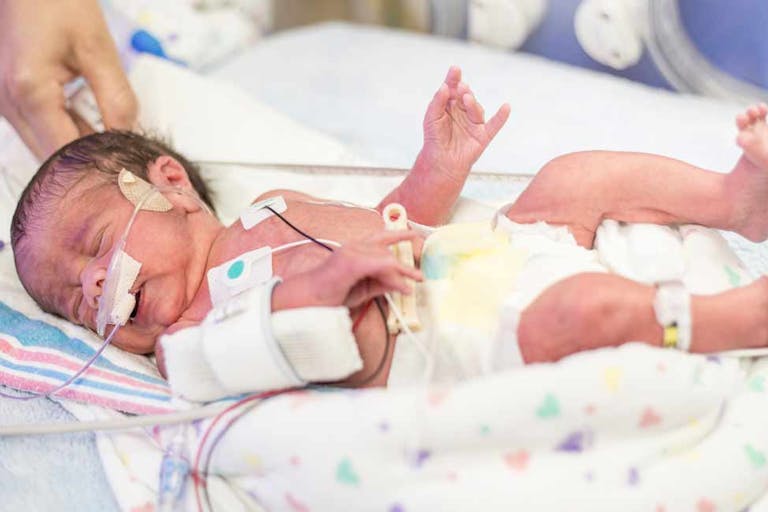
Pastor misrepresents pro-life position in ‘scientifically illiterate’ defense of IVF
Nancy Flanders
·
US premature birth rate highest in 15 years, while infant mortality rate declines
According to the March of Dimes, the number of premature babies born in the United States is at a 15-year high. The preterm birth rate now stands at 10.5%. The infant mortality rate, however, has declined from 6.1 per 1,000 live births to 5.4.
“This year’s report sheds new light on the devastating consequences of the pandemic for moms and babies in our country,” said Stacey D. Stewart, President and CEO of March of Dimes. “While fewer babies are dying, more of them are being born too sick and too soon which can lead to lifelong health problems. Pregnant women with COVID have a 40% higher risk of preterm birth and we know more women are starting their pregnancies with chronic health conditions which can further increase their risk of complications. It’s clear that we’re at a critical moment in our country and that’s why we’re urging policymakers to act now to advance legislation that will measurably improve the health of moms and babies.”
According to the organization, more than one in 10 babies born in the U.S. last year were delivered at least three weeks early, an increase of four percent from 2020. Babies born prematurely face an increased risk of both long and short-term physical and cognitive complications.
“This is the highest preterm birth rate that we’ve ever recorded,” said Dr. Zsakeba Henderson, the deputy chief medical and health officer for the March of Dimes.
Article continues below
Dear Reader,
In 2026, Live Action is heading straight where the battle is fiercest: college campuses.
We have a bold initiative to establish 100 Live Action campus chapters within the next year, and your partnership will make it a success!
Your support today will help train and equip young leaders, bring Live Action’s educational content into academic environments, host on-campus events and debates, and empower students to challenge the pro-abortion status quo with truth and compassion.
Invest in pro-life grassroots outreach and cultural formation with your DOUBLED year-end gift!
Black and Native American mothers continue to be the most at-risk women for premature labor, according to the March of Dimes, with women of color being 60% more likely to give birth prematurely.
Risk factors for premature birth include pregnancy with multiple babies, problems with the uterus, cervix, or placenta, smoking and drug use, infections, high blood pressure, diabetes, stress, and the mother being underweight or overweight. The March of Dimes listed inadequate prenatal care and preexisting maternal health conditions as two factors for premature birth, and said the COVID-19 pandemic “has further exacerbated the struggle for parents to access maternal care from hospitals and other prenatal providers.”
In addition, the Mayo Clinic notes that a woman’s multiple abortions as well as conceiving through the use of IVF also increase the chances a baby will be born prematurely.
There was an increase of nearly eight percent in abortions in the U.S. in 2020, up to 930,160 from 862,320 in 2017. In addition, there has been an increased demand for IVF, which is expected to continue due to the impact of the COVID-19 pandemic; this reportedly caused women to delay having a child, according to research published in the journal Reproductive Sciences. The longer women wait to have children, the more likely they will turn to reproductive technology for assistance, and babies conceived using assisted reproductive technology are at a greater risk of premature birth.

Live Action News is pro-life news and commentary from a pro-life perspective.
Contact editor@liveaction.org for questions, corrections, or if you are seeking permission to reprint any Live Action News content.
Guest Articles: To submit a guest article to Live Action News, email editor@liveaction.org with an attached Word document of 800-1000 words. Please also attach any photos relevant to your submission if applicable. If your submission is accepted for publication, you will be notified within three weeks. Guest articles are not compensated (see our Open License Agreement). Thank you for your interest in Live Action News!

Nancy Flanders
·
Issues
Bridget Sielicki
·
Issues
Nancy Flanders
·
Politics
Bridget Sielicki
·
Issues
Sheena Rodriguez
·
Guest Column
Right to Life UK
·
Issues
Nancy Flanders
·
Human Interest
Nancy Flanders
·
Investigative
Nancy Flanders
·
Pop Culture
Nancy Flanders
·
Human Interest
Nancy Flanders
·